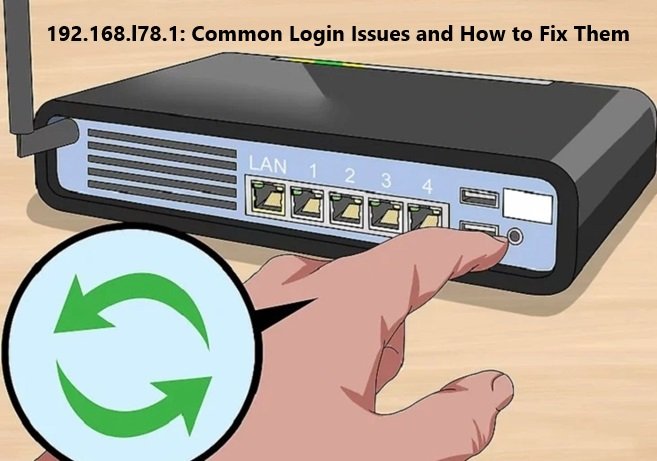If you’ve ever needed to log in to your router settings to configure your home network, you’re likely familiar with IP addresses like 192.168.l78.1. However, this address isn’t quite right. While many routers use IP addresses that start with “192.168”, 192.168.178.1 is the correct IP address commonly used by certain brands of routers, including those from Fritz!Box. Unfortunately, it’s easy to mistype and encounter issues while attempting to log in. This guide will help you understand how to access your router, troubleshoot login issues, and secure your network.
What is 192.168.l78.1?
Firstly, let’s clarify the address itself. 192.168.l78.1 is a common typographical error made when trying to access a router’s login page. The correct address should be 192.168.178.1, which falls within the private IP address range used for local area networks (LANs). These addresses aren’t accessible from the internet, making them secure for home networks.
Typically, IP addresses like 192.168.178.1 are used to access router settings, allowing users to manage Wi-Fi settings, security protocols, and connected devices.
Common Mistakes with 192.168.l78.1
It’s easy to make a mistake when typing in the IP address. Here are some common errors and why they lead to issues:
- Typing “l78” Instead of “178”: The lowercase “l” closely resembles the numeral “1”, but using it will lead to an invalid address error.
- Using Incorrect Formats: Entering IPs in formats like “192.168.1.78.1” or “192.168,178,1” will prevent access due to incorrect syntax.
How to Access Your Router with 192.168.178.1
If you’re ready to access your router’s settings, follow these steps:
- Open Your Browser: Any modern web browser like Chrome, Firefox, or Safari will work.
- Enter the IP Address: Type http://192.168.178.1 directly into the browser’s address bar and hit Enter.
- Login Prompt: You’ll be prompted to enter your router’s username and password.
If you’re unsure of your login details, check the label on your router or consult the router’s manual. Many routers use default credentials like “admin” for both the username and password.
Common Login Issues with 192.168.178.1
Several common issues may arise during the login process:
- Forgotten Username or Password: If you’ve changed your login details from the default and can’t remember them, you’ll need to reset the router.
- Incorrect IP Address Usage: Double-check to ensure you’ve entered 192.168.l78.1 correctly.
- Browser Compatibility Problems: Sometimes, older browsers or specific settings can interfere with login access.
Troubleshooting 192.168.178.1 Login Issues
If you encounter issues, try the following troubleshooting steps:
- Verify the Correct IP Address: Ensure you’re using 192.168.178.1 and not a mistyped version.
- Clear Browser Cache and Cookies: Old data can interfere with loading pages correctly. Clearing your cache might solve the problem.
- Restart Your Router and Device: Sometimes a simple reboot can resolve connectivity issues.
Resolving IP Address Errors
IP conflicts and misconfigurations are common culprits of access problems:
- Check Your Device’s IP Configuration: On a Windows PC, you can use Command Prompt and enter
ipconfigto view your device’s IP address and ensure it’s in the same subnet as 192.168.l78.1 - Use the Command Prompt for Verification: Running
ping 192.168.178.1can help confirm if the address is accessible from your network.
Fixing Browser Compatibility Issues
If you suspect your browser is causing login problems, try these fixes:
- Try a Different Browser: Sometimes switching browsers can bypass issues specific to your current one.
- Disable Browser Extensions: Extensions like ad-blockers or VPNs might interfere with page loading. Disable them temporarily to see if that solves the issue.
Handling Forgotten Login Credentials
If you’ve changed the default username and password and can’t remember them, here’s what to do:
- Use Default Credentials: Check your router’s manual or the label for the default credentials.
- Perform a Factory Reset on the Router: Most routers have a reset button that can be pressed with a pin to restore factory settings. This will reset your username and password but also all other settings.
Addressing Router-Specific Login Problems
Some login issues are unique to specific router models:
- Firmware Updates for Your Router: If your router’s firmware is outdated, it may cause connectivity issues. Log in and check for updates.
- Verifying Router-Specific IP Address Variants: Some routers use similar IP addresses, such as 192.168.0.1 or 192.168.1.1. Confirm your router’s correct IP in its documentation.
Understanding Router Indicator Lights
Router lights are essential for diagnosing connectivity issues:
- What Different Light Colors Mean: Green lights typically indicate normal function, while red or flashing lights can signal issues.
- How to Diagnose Connection Issues Using Lights: If your router isn’t responding, the lights can indicate whether the problem is with your internet connection or the router itself.
What to Do If You Still Can’t Access 192.168.178.1
If you’ve exhausted troubleshooting steps and still can’t access the router, here are further options:
- Contact Your Internet Service Provider (ISP): Your ISP may have specific settings or restrictions in place.
- Seek Technical Support from the Router Manufacturer: Most manufacturers offer online and phone support to help resolve access issues.
Security Tips for Router Access
To protect your network, consider these security tips:
- Changing Default Passwords: Default credentials are well-known and pose security risks. Update them to a secure, unique password.
- Enabling Firewall and Encryption: Most routers have firewall settings and encryption options (like WPA3 for Wi-Fi) to enhance security.
Using Alternative IP Addresses for Access
If 192.168.178.1 isn’t working, alternative IP addresses might work depending on your router:
- Trying IPs Like 192.168.0.1 or 192.168.1.1: These are common for many routers. Check your router’s documentation to verify.
- How to Identify the Correct IP for Your Router: You can also check the IP address by using your device’s network settings or router label.
Advanced Troubleshooting Techniques
If you’re familiar with networking, these advanced tips might help:
- IP Conflict Resolution: If multiple devices use the same IP, conflicts can arise. Assign static IPs to avoid this.
- Port Forwarding and Network Configuration: Port forwarding may resolve access issues in specific scenarios, like connecting multiple routers or accessing remote services.
Conclusion
Accessing your router via 192.168.178.1 can sometimes be a hassle due to login errors, mistyped IPs, and browser compatibility issues. By understanding these common issues and applying the troubleshooting steps discussed, you’ll be better prepared to fix problems and manage your network securely. Always remember to change default passwords, enable encryption, and keep your router’s firmware up to date for optimal performance and security.
FAQs
1. Why can’t I access 192.168.178.1?
Check that you’ve typed the address correctly, and confirm your device is connected to the router’s network. Try clearing browser cache and resetting your router.
2. What should I do if I forget my router password?
You can reset your router to factory settings, which will restore the default login credentials, or refer to the router’s manual for help.
3. Can I change the IP address of my router?
Yes, most routers allow you to change the default IP address through the settings menu. This can improve network security and prevent conflicts.
4. How do I find my router’s default IP address?
You can find it on a label on the router or by using ipconfig in Command Prompt on Windows or ifconfig on a Mac.
5. Is it safe to change router settings?
Yes, but ensure you know what each setting does. Misconfiguration can lead to connectivity issues or security vulnerabilities. Consult your router’s manual for guidance.
Also, Read About. TheJavaSea.me Leaks AIO-TLP.




